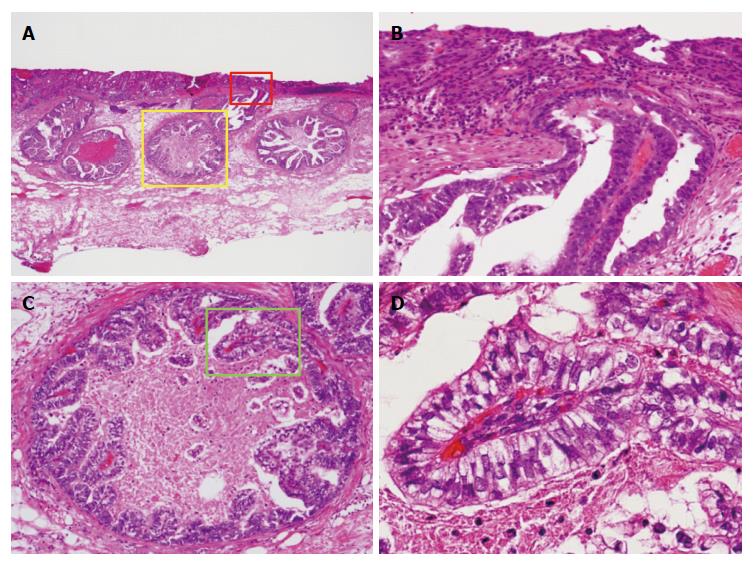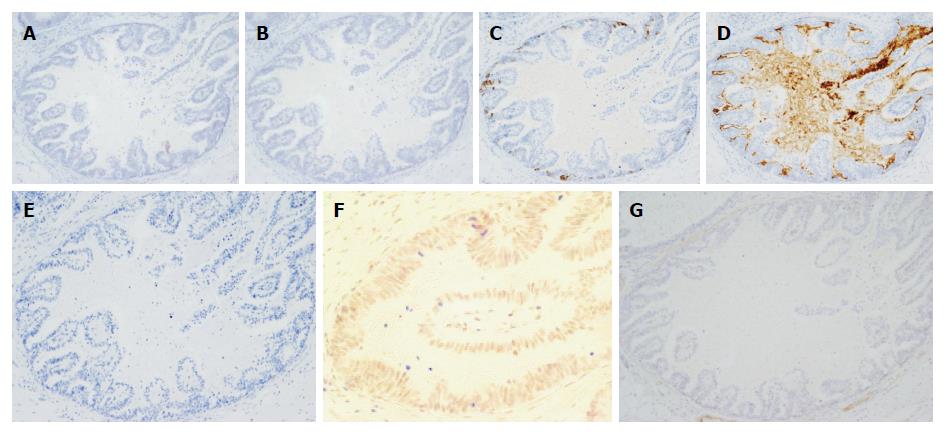Copyright
©The Author(s) 2016.
World J Gastroenterol. Sep 28, 2016; 22(36): 8203-8210
Published online Sep 28, 2016. doi: 10.3748/wjg.v22.i36.8203
Published online Sep 28, 2016. doi: 10.3748/wjg.v22.i36.8203
Figure 1 Endoscopic findings (case 1).
A: Endoscopic examination with a white light image revealed a 10 mm reddish depressed lesion on the posterior wall in the middle third of the stomach. There were no specific features of deep submucosal invasion; B: Endoscopic examination with narrow band imaging (NBI). A demarcation line was clearly present between a depressed lesion and the surrounding mucosa; C: Magnifying endoscopy with NBI findings. Within the demarcation line, an irregular microvascular pattern (bizarre and tortuous vessel) and an irregular microsurface pattern (curved marginal crypt epithelium) are demonstrated. There were no specific features of GCED. GCED: Gastric cancer with enteroblastic differentiation.
Figure 2 Histological examination of the resected specimens with hematoxylin and eosin stain (case 1).
A and B: The superficial mucosal layer was covered with a well differentiated adenocarcinoma; B-D: Carcinoma cells with clear cytoplasm had tubulopapillary growth, resembling the primitive gut. These carcinoma cells arose from the deeper part of the mucosal layer and invaded into the submucosal layer by venous invasion. There was no severe stromal reaction at the submucosal layer. Pathological diagnosis was as follows: stomach (ESD): adenocarcinoma with enteroblastic differentiation, 0-IIc, 11 mm × 9 mm, well-differentiated carcinoma > moderately-differentiated carcinoma, papillary adenocarcinoma, SM (1500 μm), ly (-), v (+), HM0, VM0. SM: Submucosa; ESD: Endoscopic submucosal dissection.
Figure 3 Immunohistochemical examination of resected specimens (case 1).
A: MUC2; B: MUC5AC; C: MUC6; D: CD10; E: AFP; F: Glypican 3; G: SALL 4. The lesion had focal positivity for MUC6, diffuse positivity for CD10, weak positivity for Glypican 3 and negative staining for MUC2, MUC5AC, AFP and SALL4.
- Citation: Matsumoto K, Ueyama H, Matsumoto K, Akazawa Y, Komori H, Takeda T, Murakami T, Asaoka D, Hojo M, Tomita N, Nagahara A, Kajiyama Y, Yao T, Watanabe S. Clinicopathological features of alpha-fetoprotein producing early gastric cancer with enteroblastic differentiation. World J Gastroenterol 2016; 22(36): 8203-8210
- URL: https://www.wjgnet.com/1007-9327/full/v22/i36/8203.htm
- DOI: https://dx.doi.org/10.3748/wjg.v22.i36.8203











